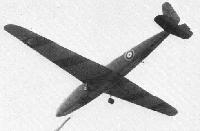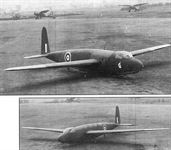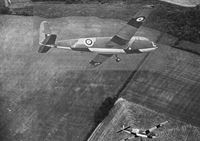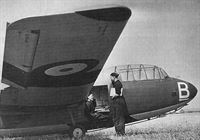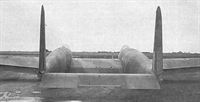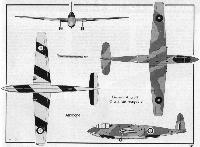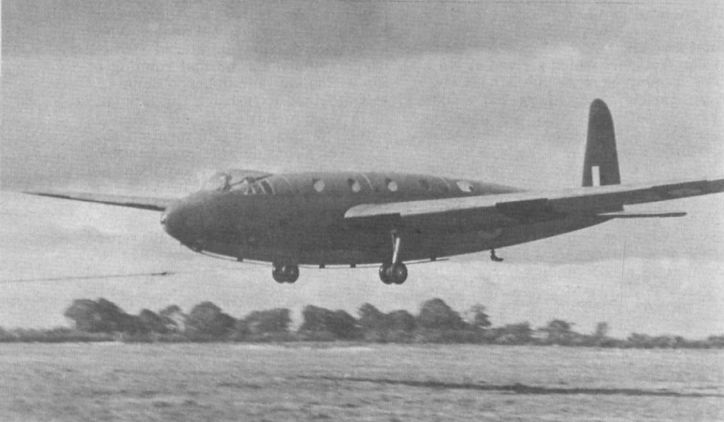
Описание
Страна : Великобритания
Год : 1940
Планер
Учебный планер с экипажем из одного человека
General Aircraft G.A.L.48 Hotspur
G.A.L.48 Hotspur - десантный планер для перевозки семи человек (плюс один пилот) на расстояние 160 км при отцепке на высоте 6100 м. Планер был спроектирован согласно спецификации 10/40, выпущенной Министерством авиации. Первый полет среднеплан деревянной конструкции Hotspur Mk I выполнил в ноябре 1940 года. В ходе летных испытаний планер показал соответствие требуемым характеристикам. Построили всего 20 Hotspur Mk I, но на основе первого варианта были спроектированы более удачные Hotspur Mk II и учебно-тренировочный Hotspur Mk III для британских планерных школ.
Hotspur Mk II отличался от первого варианта крылом уменьшенного до 4,88 м размаха, измененными фонарем кабины, входной дверью и наличием двойного управления. Hotspur Mk III имел усиленное внешними расчалками хвостовое оперение и несколько иной состав бортового оборудования. Также был построен прототип Twin Hotspur, представлявший собой два фюзеляжа стандартного планера, соединенных вновь спроектированным центропланом и общим стабилизатором; планер предназначался для перевозки 16 бойцов.
В годы Второй мировой войны построили более 1000 планеров Hotspur Mk II и Hotspur Mk III, которые использовались для обучения планеристов. Выпуск планеров был налажен на предприятиях мебельной промышленности, главным образом - на "Harris Lebus" из Тоттенхэма, в северном Лондоне.
ТАКТИКО-ТЕХНИЧЕСКИЕ ХАРАКТЕРИСТИКИ
General Aircraft G. A.L.48 Hotspur Mk II
Тип: учебный планер с экипажем из одного человека
Летные характеристики: скорость буксировки 209 км/ч; скорость планирования 145 км/ч; посадочная скорость 90 км/ч
Масса: пустого 753 кг; максимальная взлетная 1632 кг
Размеры: размах крыла 13,99 м; длина 11,98 м; высота 3,30 м; площадь крыла 25,27 м2
Полезная нагрузка: до семи десантников в закрытой кабине
- Описание
Фотографии
-
Aeroplane Monthly 1976-09 / J.Sproule - The silent service
Hotspur Mk Is had 16ft greater wing span than the Mk II. Seating was in tandem, and exit was via a removable roof, not by doors.
-
Air Enthusiast 1972-04 / ??? - The Rise and Demise of a Weapon (2)
One of the few GAL Hotspur Is, showing the long-span wing.
-
Aeroplane Monthly 1993-06 / C.Prower - From Brisfit to Beverley (3)
Регистрационный номер: BV136 Hotspur I BV136, built by Slingsby Sailplanes and delivered to the Royal Aircraft Establishment in 1941.
BV136 was one of a batch of 13 GAL Hotspur Is delivered during 1941. This Slingsby-built example spent its time with the RAE.
-
Aeroplane Monthly 1993-06 / C.Prower - From Brisfit to Beverley (3)
Регистрационный номер: BT480 Two views of Hotspur II BT480. After a period with the Central Landing Establishment, it dived into the ground during the approach to Netheravon on March 19, 1942 while with 296 Sqn. These pictures were taken in September the previous year.
-
Aeroplane Monthly 1998-12 / D.Webb - The unsung gallants /Test flyers/ (2)
An Armstrong Whitworth Whitley tows off a Hotspur glider at General Aircraft’s Hanworth Aerodrome. This was the combination which caused Davie problems when the glider overtook the tug in cloud and a large loop developed in the cable.
Другие самолёты на фотографии: Armstrong Whitworth Whitley / A.W.38 - Великобритания - 1936
-
Aeroplane Monthly 1997-03 / D.Webb - Silent warriors /Tested & failed/
Tis view of a Hotspur under tow was taken from the Hector tug. The Hectors were flown by RAF pilots, who found the job very monotonous. The Hotspur instructors were all expert glider pilots who had joined the RAF.
Другие самолёты на фотографии: Hawker Hector - Великобритания - 1936
-
Aeroplane Monthly 1976-07 / B.Gunston - Hotspur hindsight
Регистрационный номер: BT615 [2] Вариант Mk I не дотягивал примерно 27 км до требуемой дальности планирования при отцепке от буксировщика на высоте 6095 м.
A Hotspur under tow, revealing the hook-up point position. -
Aeroplane Monthly 1997-03 / D.Webb - Silent warriors /Tested & failed/
Регистрационный номер: BT605 [2] A pair of Hotspur II gliders of 2 Glider Training School being towed by a Hawker Hector in mid-1942.
-
Aeroplane Monthly 1976-07 / B.Gunston - Hotspur hindsight
Регистрационный номер: BT605 [2] -
Aeroplane Monthly 1993-06 / C.Prower - From Brisfit to Beverley (3)
Регистрационный номер: BT561 Two Hotspur IIs of 2 Glider Training School formate shortly after casting off from their tugs. BT551, nearer the camera, was destroyed on August 20, 1942 when it was towed off without a pilot front Slade Farm, Oxon!
-
Air International 1995-08 / D.Allport - Army Aviation (1)
Регистрационный номер: BT551 A pair of General Aircraft GAL.48 Hotspur II gliders bank sharply as they descend towards the landing zone during a training flight. The eight-seat Hotspur was the first military glider built by the Allies, making its first flight on November 5, 1940. Although intended as an expendable assault glider, as far as is known, the Hotspur never made any operational flights and instead became the primary operational training glider for the Glider Pilot Regiment. A total of around 1,000 were built.
Another view of Hotspur II BT551 on a training flight in 1942. The 45ft 10 3/4 in-span aircraft had a gliding speed of 90m.p.h. and a landing speed of 56 m.p.h. -
Aeroplane Monthly 1976-07 / B.Gunston - Hotspur hindsight
Coming over the hedge on finals in 1942.
-
Aeroplane Monthly 1976-07 / B.Gunston - Hotspur hindsight
Регистрационный номер: BT615 [2] Hotspur II BT615 comes in to land on its rubber-sprung wheels. Note the belly skid which it would have used in the troop carrier role, the flaps, and the black and yellow diagonal bands on its underside.
-
Aeroplane Monthly 1997-03 / D.Webb - Silent warriors /Tested & failed/
Регистрационный номер: BV200 The sole Airspeed-built Hotspur II, with revised canopy and short-span wings.
Hotspur II BV200 was evaluated by the Airborne Forces Establishment. -
Aeroplane Monthly 1976-09 / J.Sproule - The silent service
Регистрационный номер: BT596 G.A.L. Hotspur II BT596 is towed to take-off position.
-
Jane's All the World Aircraft 1980 / Encyclopedia of Aviation - Aircraft A-Z - v3
Регистрационный номер: BT671 General Aircraft Hotspur II.
-
Aeroplane Monthly 1976-07 / B.Gunston - Hotspur hindsight
A member of the Glider Pilot Regiment is briefed by an RAF instructor.
-
Aeroplane Monthly 1993-06 / C.Prower - From Brisfit to Beverley (3)
This view of a Hotspur II, taken in June 1942, shows entry into the training glider.
-
Aeroplane Monthly 1993-08 / Skywriters
Army pupils listen attentively while an RAF instructor runs over the salient points of the Hotspur glider in mid-1942. Trainees were first taught to fly powered aircraft before being sent to Glider Training School.
-
Air-Britain Aeromilitaria 1980-02
GAL Hotspurs and glider-tug Audax K7328 of No.2 Glider Training School, Weston-on-the-Green, 24.6.42
Другие самолёты на фотографии: Avro Anson / Type 652 - Великобритания - 1935Hawker Audax - Великобритания - 1931
-
Aeroplane Monthly 1976-07 / B.Gunston - Hotspur hindsight
Hotspurs at a Glider Training School, 1942. Avro-built Audax tug K7328 and an Anson can be seen in the distance.
Другие самолёты на фотографии: Avro Anson / Type 652 - Великобритания - 1935Hawker Audax - Великобритания - 1931
-
Aeroplane Monthly 1976-07 / B.Gunston - Hotspur hindsight
Регистрационный номер: BT642 Hotspur IIs on the ground and airborne. The undercarriage was not jettisoned on training flights.
-
Aeroplane Monthly 1994-11 / G.Wansbrough-White - What's in a name? (1)
A 1943 photograph of 16 Empire Central Flying School types.
Другие самолёты на фотографии: De Havilland Mosquito B / D.H.98 - Великобритания - 1940Hawker Typhoon - Великобритания - 1940
-
Aeroplane Monthly 1993-06 / C.Prower - From Brisfit to Beverley (3)
Six Hotspur IIs on an outing, towed behind three Hawker Hectors. The three ageing, camouflaged Hawker Hectors on the left are the tugs for the three rearmost gliders. Audaxes, Lysanders and Master IIs also served in this role.
During 1942 RAF pilots were training army crews to fly Hotspurs. Carrying a pilot and seven troops, the Hotspur was able to glide 83 miles from 20,000ft. The original specification had a requirement which called for a glide of 100 miles from that height.Другие самолёты на фотографии: Hawker Hector - Великобритания - 1936
-
Aeroplane Monthly 1976-09 / J.Sproule - The silent service
Picture shows a quintet of Hotspurs being towed by Hectors.
Другие самолёты на фотографии: Hawker Hector - Великобритания - 1936
-
Мировая Авиация 139
"General Aircraft" построила единственный прототип Twin Hotspur, который по вместимости вдвое превосходил обычный Hotspur.
The GAL Twin Hotspur was an interesting but unsuccessful attempt to produce a larger-capacity glider from Hotspur components. -
Aeroplane Monthly 1993-06 / C.Prower - From Brisfit to Beverley (3)
View of the GAL Twin Hotspur. Pilots disliked the sensation of being constantly accompanied in such close formation by another glider!
-
Aeroplane Monthly 1997-03 / D.Webb - Silent warriors /Tested & failed/
A Horsa (Hotspur ???) pilot’s view of the tug aircraft which, in this case, is a Miles Master.
Другие самолёты на фотографии: Miles Master II M.19 / Master III M.27 - Великобритания - 1939
-
Aeroplane Monthly 1993-06 / C.Prower - From Brisfit to Beverley (3)
1941 recognition artwork of the Hotspur I.
-
Aeroplane Monthly 1976-07 / B.Gunston - Hotspur hindsight
General Aircraft G.A.L.48 Hotspur 2
-
Air Enthusiast 1972-04 / ??? - The Rise and Demise of a Weapon (2)
The GAL Twin Hotspur.
- Фотографии

